Alsace Clarity

From Rivalry to Revelry
By Panos Kakaviatos for Wine Chronicles
12 November 2025
It was a night to remember in Colmar! 🌟
The 6th annual post-harvest dinner – known as Widderkumme – gathered representatives from 19 top Alsace wineries, see above photo — each devoted to expressing the soul of their terroirs, from crystalline Riesling and textured Pinot Gris to ever-improving Pinot Noir and exuberant, spicy Gewürztraminer.
Some 200 guests attended, traveling from across the globe — including acclaimed wine critic and award-winning author Ian D’Agata, who is based in Shanghai. I met podcasters and discerning private buyers, all united to celebrate Alsace’s unique mosaic of soils and styles.
As the excellent Alsace Wine Council website explains: Alsace geology is a like a mosaic, from granite to limestone along with clay, shale, and sandstone. Occupying a surface area of about 15500 hectares, this large patchwork of terroirs is absolutely ideal for numerous grape varieties to happily flourish. The terroir imprint bestows extra character and soul to Alsace wines, which are both unique and complex.
The illustration below, from the website, outlines no less than 13 different types of soils. They include mountainside soils of (1) granite and gneiss located on the Vosges mountain sides, (2) shale, a flaky rock made from the compression of clay within the lithosphere, (3) volcanic-sedimentary terroirs based on lava and ashes which became solid under water and (4) sandstone. Along the sub-Vosges hills, soils include (5) calcareous terroirs: sea-based limestone from the Mesozoic period, (6) marl-calcareous, thick clay deposits (marl) and calcareous pebbles, (7) marl-sandstone, (8) marl-limestone-sandstone, (9) calcareous-sandstone terroirs and (10) clay-marl terroirs. On the plain, soils include (11) colluvial and piedmont plain, (12) alluvial and (13) loess and loam – each of these types directly affecting the taste of the wines (along with the winemaking methods, of course!). I highly recommend readers to take a look at this page for more details.
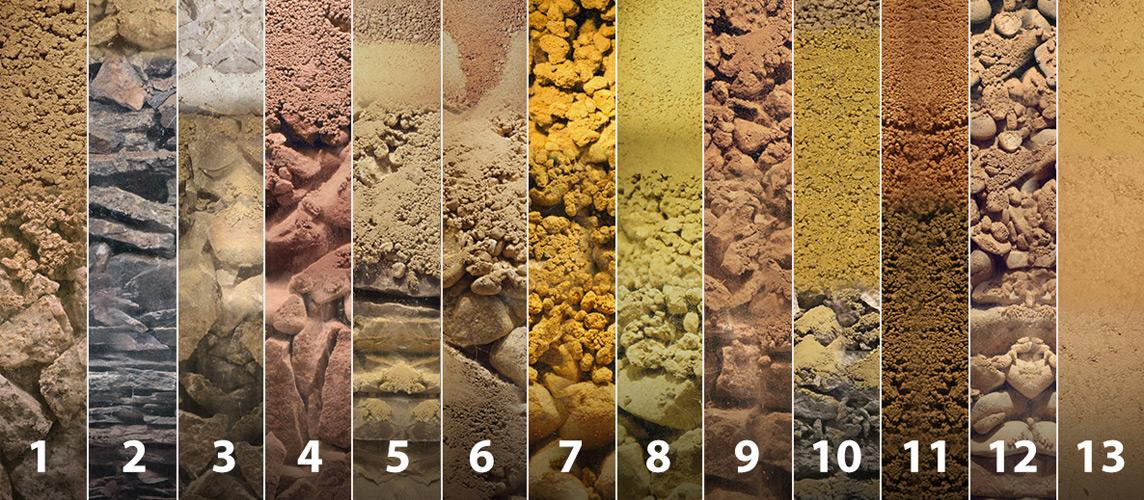
Wonderful setting, thanks to Alsace Crus et Terroirs
The tasting and dinner was held in the magnificent Salle des Catharinettes, where a life-size Statue of Liberty greeted guests at the entrance. Special note: Frédéric Auguste Bartholdi, born in the Alsatian wine capital Colmar on 2 August 1834 is best known for designing Liberty Enlightening the World, commonly known as the Statue of Liberty, which is located in New York.
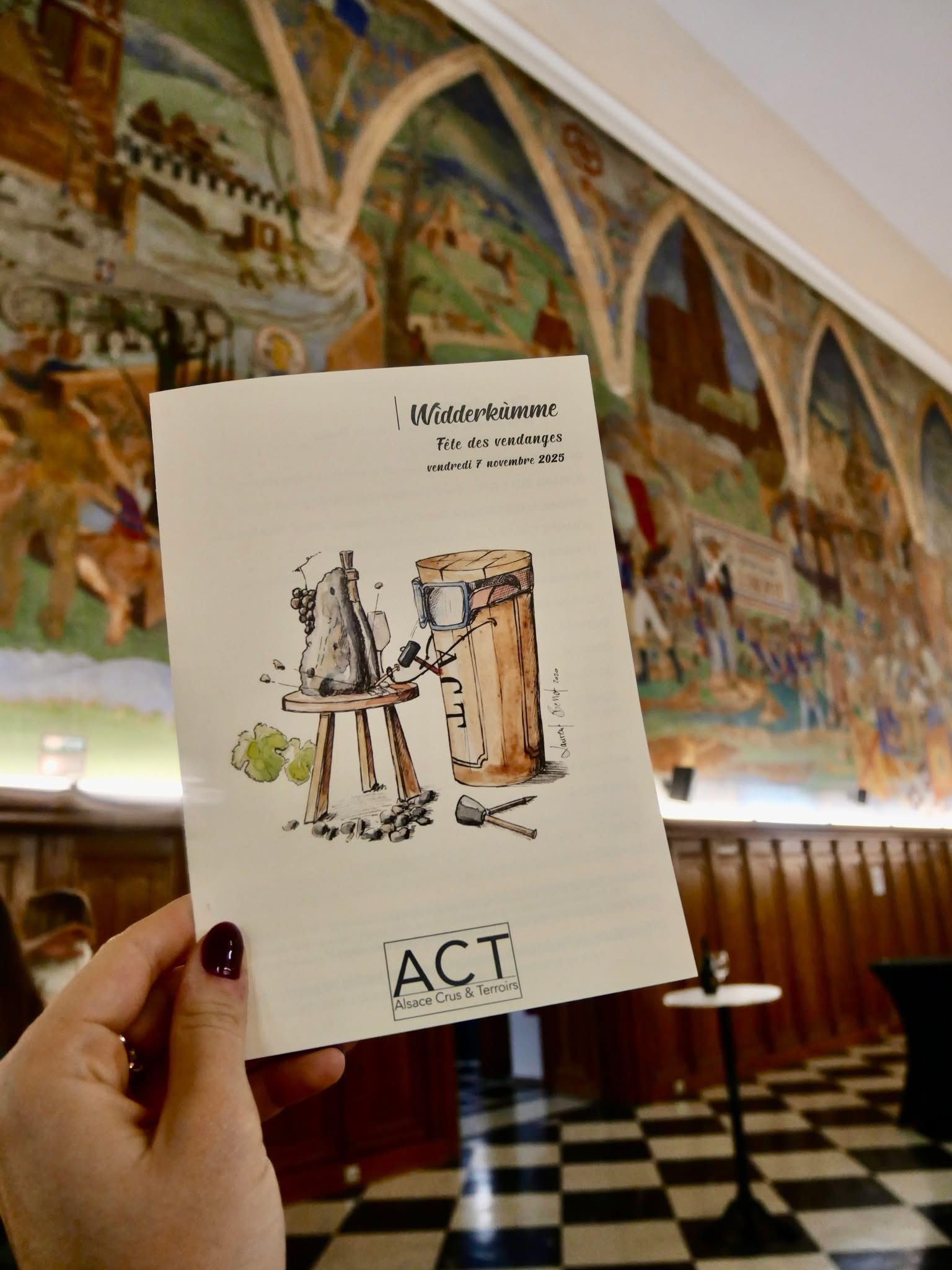
The evening began with tastings at 6 p.m., shimmering under vaulted arches, before the curtains lifted for a seated dinner with live music. 🎶
The group of 19 wineries make up Alsace Crus et Terroirs (ACT) – modelled somewhat after the German private grouping VDP. They organise tastings across France and in major cities in worldwide markets to better explain what Alsatian wine is.
A daunting task!
Are Alsace Rieslings sweet? Not at all. Please take a look at the video below with Ian D’Agata. Indeed, starting with the 2021 vintage, non-late harvest Alsace Riesling must be “dry”, as defined by EU regulations, according to a decree agreed by a two-thirds majority of the Alsace Winegrowers’ Association (AVA). The move comes in addition to the introduction of a standardized way of communicating sweetness levels on Alsace AOC still wines. Most back labels indicate specific dryness levels. I would think that an even better step would be to indicate dry on the front label, but readers should know that Alsace Riesling is dry, unless a late harvest style. As per EU rules, a dry wine can contain a maximum of four grams per litre (g/l) of residual sugar, but the limit rises to 9g/l if total acidity – measured in g/l of tartaric acid – is not less than 2g/l lower than the sugar content.
Are Alsace wines German? No. Even though many categorize Alsatian wines with Austrian and German, they are neither German (nor Austrian). And yet one winemaker told me he has an easier time selling his Riesling in Tokyo than in Paris, as many French associate Alsace with all things Germanic. Sure, the grape Riesling is German, and the names of most terroirs sound German, from Altenberg de Bergbieten to Schlossberg. In addition to the German sounding names, Alsace wine bottles resemble German shaped bottles, as opposed to the Bordeaux or Burgundy shaped bottles that dominate most other French regions, from the Loire to the Rhone. They are longer – and somewhat harder to store in wine fridges, but I digress. But Alsace is in France.
Revel in the richness
And ACT revels in this richness to prove the point that Alsace is also unique. When it was part of the German Empire (1871 to 1918), “my grandfather told me that Alsace wines always tasted richer than wines crafted on the other side of the Rhine,” remarked Alexandre Schoffit of the eponymous domain near Colmar. The geography of Alsace’s wine growing area is determined by two main factors: the Vosges mountains to the west and the Rhine river to the east. The vineyards are concentrated in a narrow strip, running in a roughly north–south direction, on the lower eastern slopes of the Vosges, at altitudes of 175–420 metres (574–1,378 ft). Those altitudes provide a good balance between temperature, drainage and sun exposure under Alsace’s growing conditions. Because of predominantly westerly winds, the Vosges mountains tend to shelter Alsace from rain and maritime influence, and the region is therefore quite dry and sunny. And I adored the superlative Domaine Schoffit Grand Cru Rangen Clos Saint-Théobald Riesling 2023, a very smooth yet lively expression of Riesling, and even if young, it was already drinking well (95/100).

Marion and Alexandre Schoffit of the eponymous estate.
Another aspect of Alsace has been intense competition among winemakers to gain limited market share, but – finally – ACT has come together with the philosophy of force in unity. As one winemaker confided to me: “Our parents would never have done this,” evoking the days when rivalry ran like a cold wind through Alsace’s vineyards — a Game-of-Thrones chapter now closed. Today, collaboration and pride define this complex, beautiful, and still misunderstood region. ✨🍷
I cannot recommend enough the great wines of Alsace. Below, some tasting notes highlights from the evening:
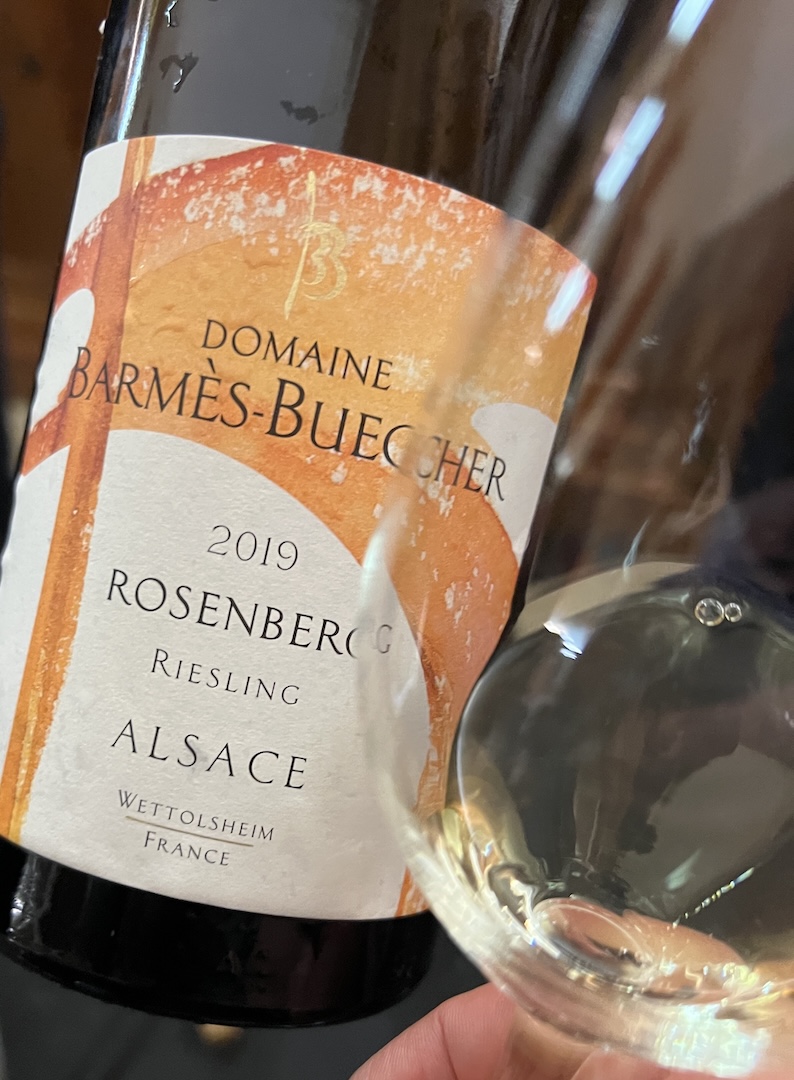
No need to be a Grand Cru to be grand.
Domaine Barmès-Buecher Rosenberg Riesling 2019 – From a magnum, intense and powerful, with an almost tannic feel to its full body white, very special! Rosenberg means “mountain of roses,” with soils of clay-limestone and sandstone: an emblematic terroir of the Barmès Buecher estate, and the Riesling mirrors the potential of this terroir, with citrus and crisp fruit. Not even a grand cru, but a superb lieu dit, the wine displays a palate of power along with salinity and depth, leading to a magnificent, long finish of citrus with touches of passion fruit. A wine that is complete, spherical. Aged 11 months in vats and large oak barrels, fermentation with indigenous yeasts. The 19-hectares estate (rather large for Alsace) has been organic and biodynamic for some 15 years already. I kept returning to this wine as a bookmark, proving that 2019 is an excellent Alsace vintage. (96/100)
Domaine Kirrenbourg Grand Cru Brand Riesling 2020 – Also from magnum, this wine has plenty of depth and breadth, and could be compared to a fine Meursault, even if it is Riesling. The Brand Grand Cru has granite soils facing south/southeast, known for obtaining optimal ripeness and evincing minerality. While the wine is more intense than the Rosenberg, with plenty of juiciness and mid-palate sap, you get a touch of heat and hint of sweetness that was not in the preceding wine, which I prefer. (94/100)
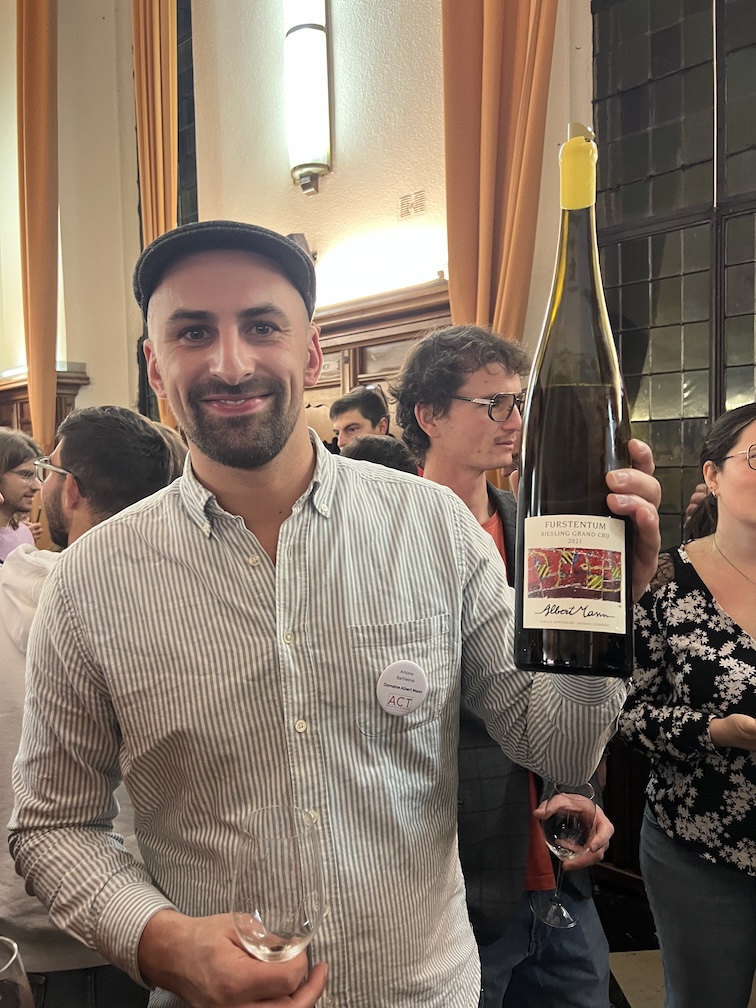
Domaine Albert Mann Furstentum Grand Cru Riesling 2021 – Served from yet another magnum, by co-owner Antoine Barthelmé, at left. With a brisk attack, this wine evokes power, coolness and plenty of citrus including grapefruit and lime. The vintage was cool, the wine thus reflecting more precision and linearity than breadth, but with harmony and refinement: one of my favorites tasted over the evening. The Furstentum Grand Cru includes limestone soil, which often results in chiselled wines like this one and bright aromatic expression. Long finish. Thoroughly dry and exciting! (96/100)
Valentin Zusslin Grand Cru Pfingstberg Riesling 2019 – I do not know this estate as well, but yet more proof that 2019 is a great vintage: Bracing acidity, juiciness, subtle wet stone (not petrol), brisk even if not as long as the Albert Mann Riesling. At a high elevation of between 270 and 370 meters, the soils of the Pfingstberg are marl-limestone and sandstone. (95/100)
Domaine Zind-Humbrecht Clos Jebsal Pinot Gris 2020 – Some participants picked this Pinot Gris as the wine of the evening, and I would see why. For many years this wine reflected botrytis in the grapes, but – as the estate explains: the development of noble rot in a warmer climate is not conducive to preserving acidity and, above all, botrytis takes on a completely different aspect, much less noble. In 2020, a very early year, the domain decided to harvest grapes before botrytis developed. So 2020 is the driest Jebsal in domain history: a style is set to last. And a style I love. Robust, packed with juicy fruit, seamlessly round yet textured on the palate leading to a long finish. You have to taste it to understand it. It would go very nicely with seared scallops in a cream sauce. About the location: Clos Jebsal is located just below the Grand Cru Brand, separated by a geological fault that delineates the primary granite of Brand and the gypsum marl of Keuper on Jebsal. It is a small 1.3-hectare Clos that was rebuilt by Léonard Humbrecht in the 1970s, then replanted with Pinot Gris in 1983. Facing south on a very steep slope, the grapes ripen quickly. The marl soil is deep and cold at the bottom of the Clos and on the terraces, while limestone is more prominent in the upper part. Bravo! (96/100)
wine reflected botrytis in the grapes, but – as the estate explains: the development of noble rot in a warmer climate is not conducive to preserving acidity and, above all, botrytis takes on a completely different aspect, much less noble. In 2020, a very early year, the domain decided to harvest grapes before botrytis developed. So 2020 is the driest Jebsal in domain history: a style is set to last. And a style I love. Robust, packed with juicy fruit, seamlessly round yet textured on the palate leading to a long finish. You have to taste it to understand it. It would go very nicely with seared scallops in a cream sauce. About the location: Clos Jebsal is located just below the Grand Cru Brand, separated by a geological fault that delineates the primary granite of Brand and the gypsum marl of Keuper on Jebsal. It is a small 1.3-hectare Clos that was rebuilt by Léonard Humbrecht in the 1970s, then replanted with Pinot Gris in 1983. Facing south on a very steep slope, the grapes ripen quickly. The marl soil is deep and cold at the bottom of the Clos and on the terraces, while limestone is more prominent in the upper part. Bravo! (96/100)
Domaine Frédéric Mochel Altenberg de Bergbieten Grand Cru Muscat – I tried three different Muscats at this festival, one being more serious, another light and bright, and this one … just right. Pure joy, this 2022. Dry and with much juiciness. Grapey as any Muscat should be, but at once exuding impressive depth and texture as well as lighthearted summer fun. Winemaker Guillaume Mochel explained that it was a hot vintage so he harvested the grapes to full maturity, so even if the alcohol is high – 14.5% – you do not notice heat. A brilliant Muscat! 96/100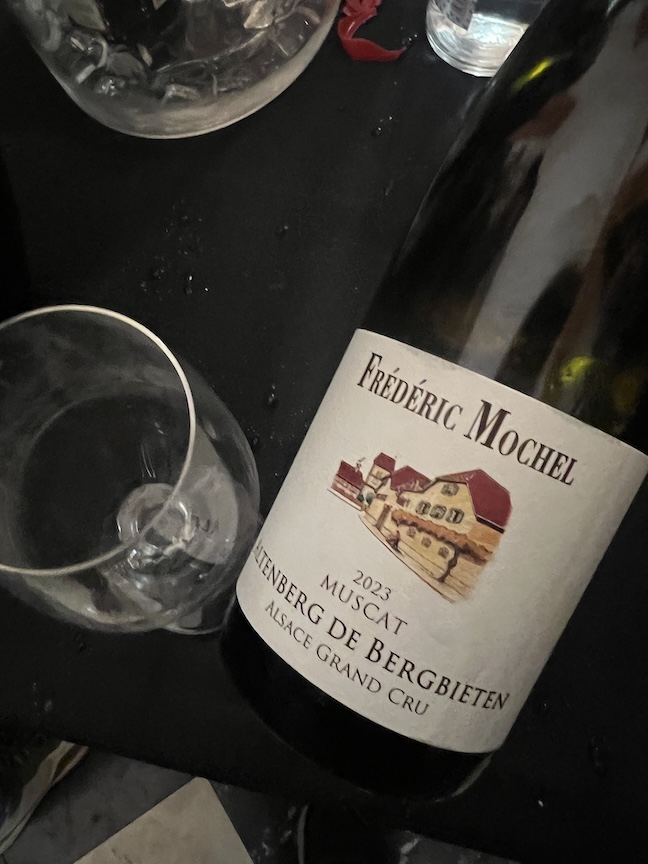
Domaine Paul Ginglinger Pfersigberg Grand Cru Riesling 2019 – Another excellent 2019 Riesling, from vines grown at about 200 meters in altitude, lots of limestone, and the wine feels consequently fresh with some yellow fruit – crunchy apricot – along with subtle wet stone seriousness, expressed in a lively and juicy mid palate leading to a long finish. Coming from another magnum bottle. 96/100

A bit more please : Foulques Aulagnon getting super Riesling from Jeroboam, served by Véronique Muré
Domaine Muré Clos Saint Landelin Grand Cru Vorbourg Riesling 2019 – And the wine that got most of the cherry cakes that evening was this gorgeous Riesling served from one of only four Jeroboam bottles – the equivalent of six standard bottles – produced at the estate, served to diners by co-owner Véronique Muré. Plenty of wet stone with fresh citrus and subtle stone fruit and spring flower. The palate exuded depth and subtle breadth, mid palate sap and a long cool yet rich finish! Located in Rouffach, Clos Saint Landelin, is owned exclusively by the Muré family, covering an area of 12 hectares, forming the southern tip of the Vorbourg grand cru. Located at the end of the valley, it faces south and enjoys excellent sunshine until the end of the day. North and southwesterly winds ensure good health until harvest time. The steep slopes – you get a great view when you visit the estate – require terraced cultivation. The soil is marl-limestone; it is stony; the subsoil is formed of Oligocene conglomerates with oolitic limestone pebbles. All these elements make it a terroir with great character. The vineyard is cultivated using biodynamic agriculture. The vines are planted densely, at around 10,000 vines per hectare. (96/100)
Now, I could not include all tasting notes from this amazing evening but suffice to say: not a single bad wine among the scores of pours. Alsace is making wines better than ever, and you, dear reader, should take time to discover these wines the next time you visit your favorite wine shop. Cheers! 🙂
 Wine Chronicles
Wine Chronicles
Share This